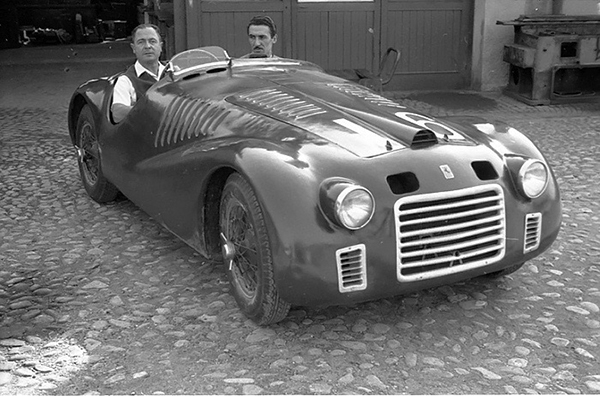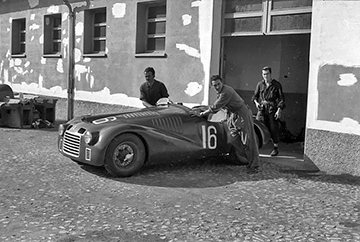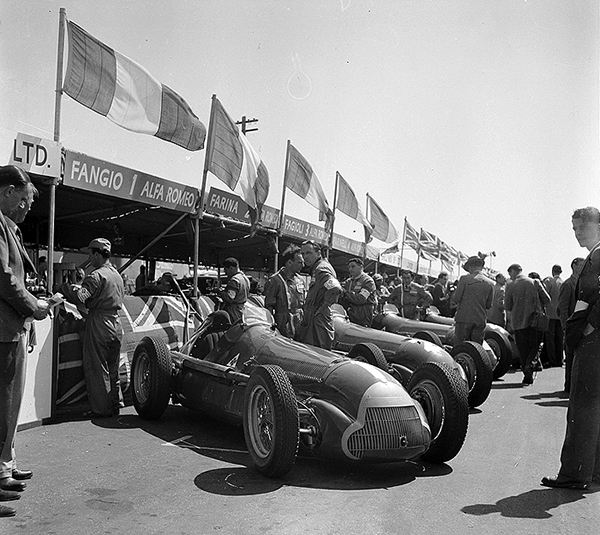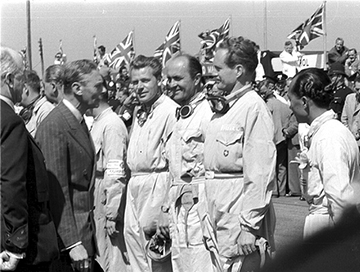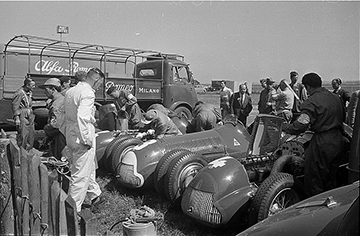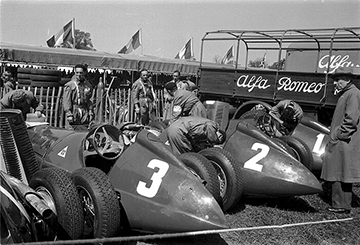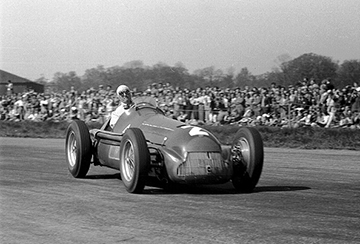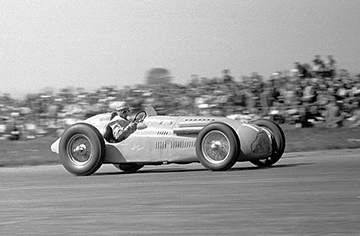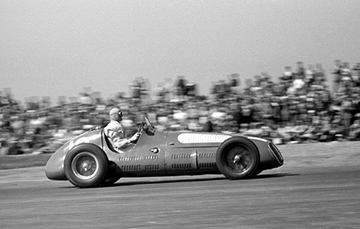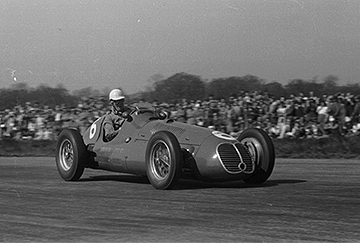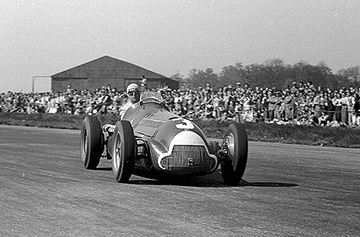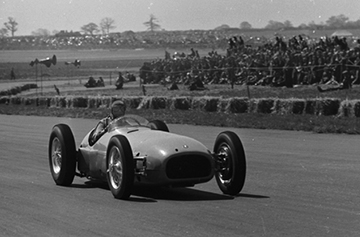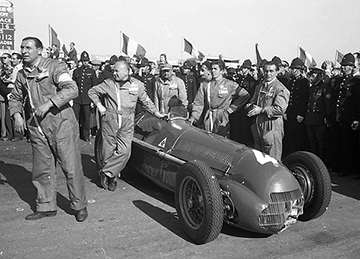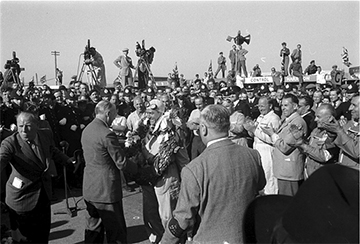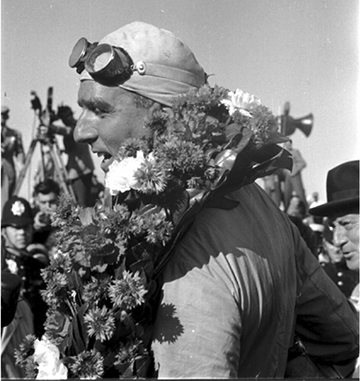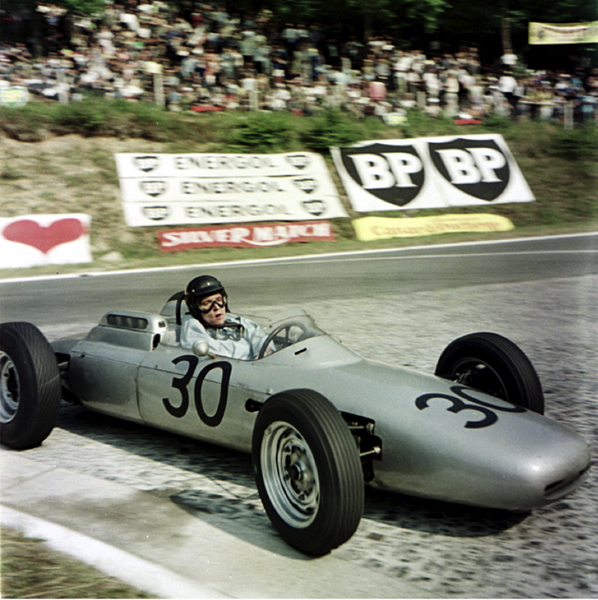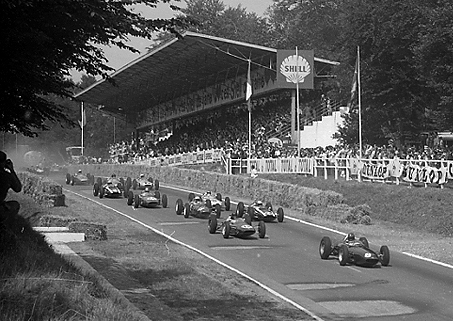In the Ferrari factory yard in Maranello on September 27, 1947, this new sports car is the final envelope body iteration of, we believe, chassis 01C, the very first Ferrari sports car. This latest body, showing its new hood scoop to feed the three centrally located Weber carburetors of its now 1.9-liter motor, was modified in-house at Ferrari by Aristide Govoni who may well be sitting in the passenger seat, looking somewhat nervous. At the wheel is Signor Armando Pastorino di Tortona, owner of a tool company and a friend of Enzo Ferrari, so he gets to sit in this important sports car just to have his picture taken. The new motor is simply an enlarged version of its original V12 of 1.5 liters, as first created by Gioacchino Colombo, a highly successful engine design that will endure at Ferrari in various iterations for the next 20 years.
But this car is not for show. It has just been rolled out of the Racing Department where it has been prepared for the Circuito di Modena for sports cars on the next day with its race number 16 visible on the hood and the left side as shown here. This race would be held on the streets of nearby Modena where this car will be driven by one of Ferrari’s good clients from Modena, Ferdinando Righetti.
Unfortunately, Righetti will crash the Ferrari and be forced to withdraw. During the following F1 race, there was a more serious accident which resulted in the deaths of five spectators. As a result the Modena Grand Prix was not held again inside the city but was moved to the Modena Aerautodromo starting in 1950.
However, Righetti’s car will return to Maranello where it will be repaired and again modified with a different body and another new engine to become a cycle-fendered 166 Spyder Corsa. And of course it will then have its chassis renumbered so it could be sold as a “new” racing car.
Photos from the Archivio Corrado Millanta ©The Klemantaski Collection – http://www.klemcoll.com
This past weekend was the 1000th Grand Prix of the modern era of Formula 1, held at Shanghai in China. Today let’s take a look back at some photographs from the first Grand Prix of this era. It was the British Grand Prix which also had the title of Grand Prix d’Europe and took place at Silverstone on May 13, 1950. In 1950 Alfa Romeo was the leading team with their 158 which was an update of a prewar design. Car number 1 in front of the lineup in the rudimentary Silverstone pits of the four Alfettas will be driven by Juan Manuel Fangio. Other Alfa drivers will be Giuseppe “Nino” Farina, Luigi Fagioli and British garagiste Reg Parnell.
Before the race started, King George VI (in the grey suit) greeted the drivers. Here he is speaking with Louis Chiron as Toulo de Graffenried awaits his turn and Prince Bira leans in patiently at the right. The Royal Family would watch the race from a small private elevated stand.
The Silverstone paddock was directly behind the pits and was pretty informal being simply a mown field inside the runways of the old RAF wartime airfield. Here again, is the Alfa Romeo team with car number 4 to be driven by Reg Parnell.
Here is another view of the Alfettas in the paddock with the pits in the background and the Alfa Romeo transporters at the right. Car number 3 will be driven by Fagioli and number 2 by Farina.
And here is Farina with his imperious driving position on the approach to Stowe Corner at the far end of the circuit. He swapped the lead at various times during the race with Fangio and Fagioli. Parnell was driving somewhat cautiously being a guest driver for the great Italian team.
The Talbot Lago 26C was really an open-wheeled sports car design of which there were five examples entered, two by Antonio Lago’s Automobiles Talbot-Darracq and three by private teams. This example was a Talbot team entry piloted by the French prewar driver Eugène Martin. He did not finish.
Monégasque Louis Chiron was a famous prewar driver who eventually became the oldest driver to start a Grand Prix when he drove a Maserati 250F at Monaco in 1958. At Silverstone, he was already 50 and drove a factory-entered Maserati 4CLT/48 but failed to finish.
In another Maserati 4CLT/48 was English amateur driver David Hampshire whose car was entered by Scuderia Ambrosiana. This Italian private team, created by Giovanni “Johnny” Lurani, allowed English drivers to maintain racing cars outside of England and thereby avoid both Purchase Tax and, by swapping expenses, the then limitation on taking Sterling funds outside of England.
This is Fagioli seen braking for Stowe Corner with his Alfetta. He would finish second to Farina after Fangio hit a straw bale and then suffered engine failure.
Before the start of the Grand Prix, Raymond Mays drove a slow demonstration lap in the B.R.M. 15 which was not yet ready to race after numerous disappointments. Here he is coming out of Abbey Corner and past the pits which at this time were located between Abbey and Woodcote.
The race is over and the Alfa Romeo mechanics surround Reg Parnell’s third-place car as he heads to the prize-giving. The smashed grille in its nose resulted from a fatal argument with a hare during the race. There was no other damage caused by the collision.
Nino Farina receives his laurels as the winner of the first Grand Prix counting for the World Championship which he will go on to win in 1950.
The winner and World Champion to be, Nino Farina
Photos by Alan R. Smith & Louis Klemantaski ©The Klemantaski Collection – http://www.klemcoll.com
Here is many Americans’ favorite Grand Prix driver Dan Gurney taking the Nouveau Monde hairpin at the bottom of the Rouen-Les Essarts public road circuit during the French Grand Prix on July 8, 1962, in the Porsche 801 flat-8 Grand Prix car. The Porsche was a rather new car and had recently undergone substantial suspension and bodywork revisions based on extensive testing at the Nürburgring. Gurney was not forecast to be particularly competitive – in fact, he was back on the third row of the grid – but with some attrition, he surprised everyone by taking an unexpected victory.
The week before the French race all the British teams, Lotus, Cooper, Lola and BRM, had been at the super-fast Reims circuit for the non-Championship Reims Grand Prix, the new name for the prewar Grand Prix de la Marne, joined by two privately entered Porsche 718s. Ferrari, although entered, as here at Rouen, did not show up due to metalworkers strikes in Italy.
To whet the attention of the spectators, race day began with two Formula Junior heats and even a bicycle race. But soon things got down to some real F1 racing. At the start, seen here, Graham Hill in his BRM 57 leapt out to small lead ahead of Jim Clark’s Lotus 25, Bruce McLaren’s Cooper T60 and new F1 driver John Surtees with the Lola 4-Climax. Gurney was back in sixth place but stayed in touch with the leaders. His teammate Joakim Bonnier had the second Porsche 801, but was not at Gurney’s level, the American having received the majority of the Porsche mechanics’ attention during practice.
Before long McLaren stopped at the pits, but continued a couple of laps in arrears while Brabham brought his Lotus in to retire with broken suspension. At half distance it was Graham Hill still out in front with Clark’s Lotus in second and now Gurney up to third. Clark set a new lap record, but the decided all was not well with his car and came into the pits which left Hill in the lead by some 30 seconds over Gurney while Surtees’ Lola was third but a lap down. Then, with 12 laps to go, Hill pulled off at Nouveau Monde with injection troubles which gave Gurney the lead which he carefully held to the finish. The tail-enders also found that it pays to keep running as Tony Maggs with his Lotus was second one lap down and Richie Ginther in the second works BRM was third, two laps behind.
Because of Ferrari’s absence, their World Champion Phil Hill was but a spectator at Rouen, busy taking photographs with his Leica.
Photos by Louis Klemantaski ©The Klemantaski Collection – http://www.klemcoll.com


